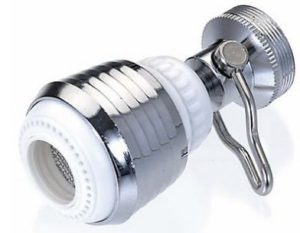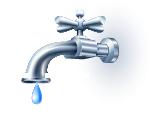What Is A Faucet Aerator?
A faucet aerator also referred to as a tap is a fitting that sits on the end of your faucet. It’s shaped like a tiny disc and help deliver a non-splashing stream of water to the end user. You can find aerators on the bottom of all the faucets in your home.
According to Water Sense, an EPA Partnership Program just by changing out old and inefficient faucets and aerators with WaterSense labeled models can save the average family household 700 gallons of water per year.
What Does A Faucet Aerator Do?
It has only one purpose and that is to control the flow rate of water coming through your faucet and it accomplishes this by mixing air with water.
Without having an aerator installed your water would clumsily flow out with a lot of unnecessary splashing in your kitchen sink and counter.
Similarly, flow reducers also act to reduce the amount of water used but they don’t usually use air to help them accomplish this task.
They simply provide a constant stream of water without any higher pressures or aeration.
Aerators act as filters and will wear out over time. Aerators need to be replaced when the spray pattern loses its shape or your water flow is reduced because of clogging.
Aerators can be changed if you’re looking to change the flow rate or flow style as well.
Typically aerators that are installed on kitchen faucets need a higher flow rate to be able to fill sinks and large pots in an efficient manner. But even in kitchen
But even in a kitchen setting high flow rates aren’t always required and installing low-flow aerators can give you the discipline required to help you conserve water.
You will be surprised at the amount of water you can save annually with this water saving device.
Laminar Flow Aerator
Faucets equipped with a laminar flow aerator deliver a stream of water that is strong, clear, calm, unbroken and constant.
Unlike traditional aerators which add air to the stream which can cause splashing and sputtering a laminar flow works by producing dozens of parallel streams of water. This produces a consistent flow rate.
Faucets with a laminar flow aerator typically exceed the requirements of the 1992 Energy Policy Act Standards for Faucet and Showerhead Fixtures.
The laminar flow is the idea spray for health care facilities since it produces a stong, clean and non-splashing stream.
Male Vs Female Aerator Threads
If you are changing out your aerator you’ll to determine whether your aerator has a male thread located on the outside or a female thread that is on the inside.
Some aerators are available as a dual thread where you have one aerator housing that with both threads along with a split washer.
Sizes of Aerators
Aerators come in three different sizes:
- Standard (size of a quarter)
- Junior (size of a nickel)
- Tom Thumb (size of a dime)
Restoring The Flow Rates of Your Faucets
If the flow rates of your faucets are flowing quite as well as they use to it may be because they just need a good old-fashioned cleaning. This is especially true if you live in a state like Arizona where the water is the hardest in the nation, 23 grains of hardness per gallon (gpg).
This hardness creates a lot of calcification on the inside of your aerators. Remove all the aerators on your faucet and let them soak in CLR which is the best product on the market that you can use to remove rust and calcium.
Allow them to soak for about 30 minutes and you will be able to restore the flow rate of all your faucets and showerheads to their normal operating flow.
How To Install A Low Flow Aerator On Your Home’s Faucet
If your faucet isn’t a low flow model you can still make it one just by installing a water saving aerator to it. It’s an easy way to conserve water and even help you save money.
If you’re still using an old and inefficient aerator you’re probably using over two gallons of water per minute just to wash your face and brush your teeth.
Anything rated 0.5 GPM of water or less is considered a low-flow aerator.
You could really cut down your water use by installing a low-flow aerator on your faucet and it’s easy.
- First, plug the sink drain just in case you drop any parts you easily retrieve them and they won’t get lost.
- Remove the end of the spout on your faucet by turning it counter-clockwise. You should be able to do this by hand. If not, carefully use a wrench or channel locks. Carefully place a clean rag between the spout and tool to avoid scratching your faucet.
- Once the end is removed check up inside the spout to make sure no other parts are stuck there.
- Once the spout is clear, grab the new aerator making sure the supplied rubber washer is in place.
- Carefully screw the new aerator onto the threaded spout end clockwise and tighten by hand. Now you can let the savings flow.
Final Thoughts
The average family of four will consume 15% of its daily water use through the use of faucets. Just by installing low-flow aerators that use 0.5 GPM instead of the typical 2.5 GPM will reduce the daily consumption of water by as much as 48 gallons per day or on 17,000 gallons per year.
Low-flow aerators are inexpensive devices that you can purchase at your local hardware store that can easily be installed by hand. They are a great investment for any homeowner.



